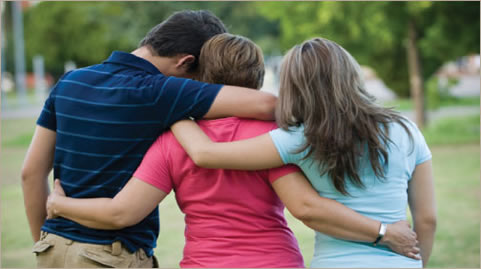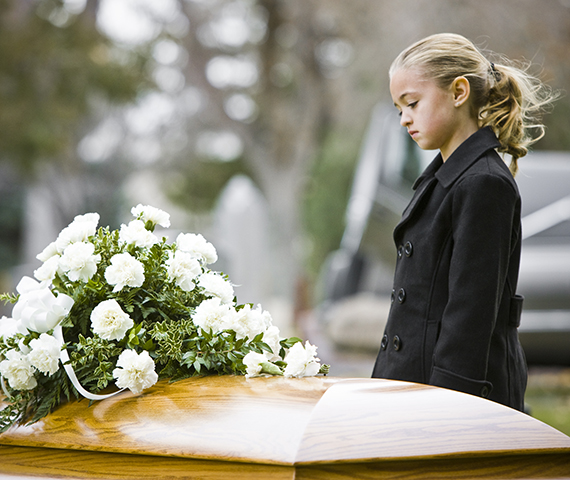Supporting Students Coping With Grief
Most people don’t want to think about the idea of death, let alone a young person having to cope with it. However, a study published in School Psychology Quarterly found that people are most likely to experience their first sudden loss during their youth—between the ages of 15 and 16.[1]
And that only covers sudden losses. “Over the course of their school lives, 9 in 10 children will experience the death of a family member or close friend. One in 20 will lose a parent … Chances are that in almost every class, in every school throughout the country, there is at least one grieving student,” according to David Schonfeld, MD, Director of the National Center for School Crisis and Bereavement.[2]
according to David Schonfeld, MD, Director of the National Center for School Crisis and Bereavement.[2]
Editor’s Note
For the purposes of this article, we’ll be focusing on grief as a response to death. However, we recognize grief can occur as a result of a variety of life changes. We strongly encourage anyone working with young people to take grief from other causes just as seriously.
Read on to learn more about grief, how it affects children and young adults, and how you can help students with their grief no matter what relationship you have with them.
What Is Grief?
At its core, grief is a deep sadness in response to loss.[3] People sometimes use grief, sadness, and depression interchangeably when talking about emotions and mental health, but they aren’t quite the same.[4]
- Grief: Direct response to a loss during which someone goes through stages
- Sadness: A response to life changes, but usually with minimal disruption to one’s life
- Depression: A mental illness involving feeling down, sometimes triggered by an event but often not
Grief can involve unexpected bouts of sadness, and it may lead to depression or suicidal thoughts. But what makes grief stand apart from the other two is its five stages:[5]
- Denial: Refusing or being unable to believe the news is true
- Anger: Anger at the situation, a higher power, yourself, those around you, or the deceased
- Bargaining: Wondering what you could have done to stop this or how to undo it
- Depression: Extreme sadness
- Acceptance: You realize things can’t be changed and begin to move forward
There’s no correct order or length of time for these stages. Grieving individuals may go back and forth between all the stages—even acceptance.
How Does Grief Affect Children and Young Adults?
Everyone experiences and acts on grief differently. Personalities and life experiences influence whether someone breaks down, remains stoic, or does anything in between.
However, grief may affect students differently than adults when it comes to their academic and social lives. Children and young adults may also be more openly affected by the death of a pet.
No matter the age of a student, remember that not everyone grieves openly. Invisible grief is still grief.
Grief’s Effects on Social Behavior
Students of all ages who experience death may withdraw from their friends, lash out in anger, and become less social. Or they may throw themselves headfirst into socializing, trying to forget the pain they’re in by having fun with their friends. Sometimes this can be harmless; however, it’s crucial to  watch out for risky behaviors.
watch out for risky behaviors.
Rick Ayers, author of “An Empty Seat in Class: Teaching and Learning After the Death of a Student,” explains the phenomenon of “some students seeking to get a social bump from being friends with the deceased. Some will even exaggerate their relationship for the sake of this bump.” He also points out that teens sometimes romanticize death, which can either appear in the form of life having more meaning or so-called “contagious suicide.”[6]
College students could experience the same stages and social behaviors as adults, behave more like teens, or end up somewhere in between.
Grief’s Effects on Academics
Worsening grades is a common effect of grief, but not all students experience this—some immerse themselves fully in their academics.
The School Psychology Quarterly study reported that adolescents often perform less well academically while grieving, feel less confident in their abilities, and may dislike school more. However, the researchers also found students’ passion for academics and its merits didn’t change at all.
If we look at college learners, we may see similar results to the adolescent study above, but they could also have additional academic challenges. As legal adults, college students may suddenly be caregivers after a death and struggle to focus on school in addition to managing new responsibilities.
Are Grief Symptoms Different for Children and Young Adults?
Grief symptoms for children and young adults have a heavy crossover with adults, but there are differences.
Young Children And Grief
According to Earl A. Grollman, an expert in death education, there’s no minimum age at which people can experience grief—even infants and toddlers recognize loss.[7] Some of the signs of grief for young children are the same as adults, but they experience and display others that adults may not. Young children may react with the following:
- Denial: Believing the whole thing is a joke, nightmare, or otherwise not real, which may last for months
- Sadness: Includes recognizable sadness and loneliness
- Panic: Worry they’re going to die the same way their loved one did or from an unrelated and even minor illness; they may fear others they love will die
- Guilt: Feeling this is their fault, blaming others for what happened, or idealizing the deceased
- Depression: Disinterest in normal activities, exhaustion, and anxiety
- Anger: Rage about why the person left them, who caused it (even the universe/a deity), and resentment toward the deceased or others around them
Unlike grief for older people, these stages aren’t set in stone. Not all kids will experience all of these, and they may experience some unexpected ones as well. They’ll eventually accept the death but may bring up the death at random for years to come.
Adolescents And Grief
Teens are already trying to figure out who they are, and the death of a loved one adds to this challenge. As Charles A. Corr, PhD, puts it, “When adolescents experience the death of a family member, a friend, a teacher, they are often left even more bewildered in their search for identity.”[8]
Additionally, while teens may understand the concept of death, they might never have thought it could happen to or around them. Teens may go through the stages of grief like adults or experience some of the symptoms younger children do, along with feelings of losing their sense of self.
Adolescents are more prone to attempt suicide when someone around them completes the act.[9] Therefore, it’s particularly important to look out for suicidal behaviors when helping teens deal with grief after a friend or family member’s suicide.
How to Help Children and Young Adults Who Are Grieving
Children and young adults need help with their grief process, even if they don’t verbalize it. If they don’t get assistance of some sort, they may end up in a tough mental spot.
Learn about how K-12 teachers and staff, college professionals, parents, mental health professionals, and even those who are grieving can help with the grief process. Each section has unique advice that’s helpful depending on your individual situation, so reading all of them will help ensure you have a variety of tactics.
How K-12 Teachers and Staff Can Help With Grief
When students experience death, whether one that results in individual grief (e.g., the death of a family member) or shared grief (e.g., the death of another student or teacher in the school), the school year doesn’t stop.
And, unfortunately, teachers and staff don’t always feel prepared to support their students during these times. In a New York Life Foundation survey of more than 650 teachers, paraprofessionals, and other school workers, just 24% say they feel very comfortable offering support to students who lose someone close to them.
someone close to them.
In fact, 92% of educators would like a greater focus on training to support grieving students, and 91% would like to participate in bereavement training. Below, we’ll discuss how K-12 teachers and school staff can support students experiencing individual and shared grief.
For Kids Experiencing Individual Grief
Every child grieves differently, and their relationship with the deceased, cultural background, and more affect their grieving. However, there are some things teachers and staff can do to help grieving students in general, according to the National Association of School Psychologists (NASP)[10] and Maryanne Schreder (expert in loss, death, and grief):[11]
- Never impose your own belief system on students.
- Keep your normal classroom routine as much as possible.
- Welcome conversation, but don’t force it.
- Talk to the student’s classmates ahead of time, both about the death and how to behave afterward. Misunderstanding and bullying may occur otherwise.
- Don’t assume you know what a student wants. Let them take the lead as much as possible.
- Allow wiggle room on assignments and exams, but don’t be alarmed if they dive into schoolwork.
- Don’t assume physical, behavioral, or emotional challenges or outbursts are intentional or “fake.”
- Allow them to have their feelings and validate them.
If you know the student well and feel they would be receptive, remind them that you’re there for them if they ever want to talk and ask for their input about their needs. Don’t force a discussion but offer to be there if they want to talk.
When a student is experiencing individual grief, it’s also important to communicate with their parent(s) or guardian(s).
Be proactive in the communication, contacting the parents before the child even returns to school, expressing condolences, and asking if there’s anything in particular they want from the team. As time goes forward, continue to check in with the parents.
Remember: The parents may not respond to you immediately, if at all. They’re dealing with a lot, which has nothing to do with how much they care about their child’s education.
For Shared Grief At School
Teachers often know about a death of a student, teacher, or involved community member before students do. They frequently discover this via email and await further instructions, trying to continue teaching as if nothing has happened.
Or something may happen overnight, and teachers get called into a meeting before school starts to discuss how to handle things with the students.
For many teachers, that’s all the training they get regarding grief, let alone shared grief.[12] However, as Ayers says, “The number-one take-home is that you have to build community now to survive crisis later. You cannot start building community when crisis strikes. All the practices you do now to enrich your classroom and school context will not only promote more engaged learning but will provide an anchor during a crisis.”[13]
In other words, schools need to assume the worst will happen and prepare for it while hoping for the best.
Once a crisis occurs, schools must make a lot of decisions. While there are variations in how to handle situations based on the person who died and the surrounding circumstances, you can implement some common practices in your school. Ayers and NASP recommend the following:
- Contact all parents directly (via email or phone) to tell them what happened, dispel rumors, and let them know of resources and assistance.
- Be totally factual with teachers, students, and parents.
- Allow teachers to make choices for their own classroom, so long as they maintain a safe environment. They know their individual classes best.
- Keep an eye on students who were particularly close to the deceased without becoming intrusive.
- Recognize you’re all going to be improvising and allow room for mistakes.
- Let students mourn however they need to.
- Have students take the lead on memorials, such as creating t-shirts or a mural, rather than forcing an idea on them.
- Give the students a chance not to have adults hovering. This allows them to talk among themselves freely (e.g., lunchroom chaperones could stand farther away than usual).
A Note Just For Teachers And Staff
It’s important to remember: The adults in the schools supporting students through grief may be grieving as well. In his book, Ayers quotes his friend Dana Moran as she talks about how she’s dealt with student deaths:
 “We fight for these kids and their lives one kid at a time and, try though we might, we cannot protect them any better than we can protect our own children. Our vulnerability is multiplied a hundred times every year that we teach…I have started calling this an ‘occupational hazard’ and it is the price we pay for loving the kids we work with. But to not love them is worse—and to not fight for/with them is unthinkable.”[14]
“We fight for these kids and their lives one kid at a time and, try though we might, we cannot protect them any better than we can protect our own children. Our vulnerability is multiplied a hundred times every year that we teach…I have started calling this an ‘occupational hazard’ and it is the price we pay for loving the kids we work with. But to not love them is worse—and to not fight for/with them is unthinkable.”[14]
You can’t, and shouldn’t be expected to, pour from an empty cup. Teachers and staff want to be strong for the kids, but it isn’t simply out of a sense of personal duty—it may be an obligation. “Teachers cry, even when there is not a major tragedy, and it is very important for students to witness their teachers as human, as it is important for them to see all adults in their lives as real, vulnerable, and caring individuals. Yet the general notion of the teacher’s role is that there is ‘no room for whining,’” says Ayers.[15]
Please make sure to give yourself care and compassion during this difficult time. Your kids need you, of course, but you need to take care of yourself before you can take care of anyone else. Get whatever help you need, whether counseling, taking a sick day, or practicing any other kind of self-care.
How Colleges Can Help Students Dealing With Grief
Chan L. Thai and Julia F. Moore of Santa Clara University report that many college students feel immense pressure to excel socially and academically while grieving, in essence being told to “get over it.” In part, this is because many institutions don’t have policies in place to assist students during their grief—even though 22% to 30% of undergrads are in the first year of grieving a loved one’s death.[16]
Thai and Moore suggest colleges engage in the following:
- Psychoeducation and Training: Ensure faculty, staff, and students have access to educational materials to help them best support grieving students.
- Outreach: In the case of a student’s death, institutions need to reach out to the family, offer condolences, and ask for additional information on what the family wants to be announced and if any other students need help.
- Bereavement Policies: Mandate accommodations for assignments and attendance in the week or weeks following the death of a student’s loved one, ensure students know these policies exist, and enforce them with professors who may have previously had policies antithetical to these.
- Bereavement Centers: While students aren’t likely to seek mental health support, preferring instead to speak to family and friends, bereavement centers for students experiencing similar losses have proven useful on campuses.
- Support Groups: While bereavement centers are formal, colleges can set up informal support groups that are sub-groups of other activities or classes students are involved with. This helps grieving students find especially like-minded people to talk to.
If you’re a professor, make sure you have a clear bereavement policy in your syllabus. Let students know how to reach you, what information you need from them, and what school policies students need to follow in addition to your own.
Teaching assistants often work with smaller groups of students, and they may be better able to form close bonds with their charges. As part of their teaching assistant training, they should learn to handle crises, communicate concerns to their mentors, and build strong relationships with students.
TO CONTINUE READING WE ASK THAT YOU GO TO THE ORIGINAL ARTICLE BY CLICKING THIS LINK (this includes the footnotes):
https://www.mswdegrees.org/resources/helping-students-cope-grief
Here are resources presented in the full article linked to above:
Resources for Dealing With Grief
A Guide to Depression and Suicide Among Students
Our article discusses signs and symptoms of depression and suicidal thoughts among young people and how to intervene when needed.
An Empty Seat in Class: Teaching and Learning After the Death of a Student
This book, written by a teacher after the death of a student, explores the topic in a frank manner and provides advice and understanding for school staff.
Bereaved Children and Teens: A Support Guide for Parents and Professionals
Drawing on 14 experts from across North America, this book explores how to help grieving young people through various lenses.
BetterHelp
This online therapy site pairs people all around the world with mental health professionals, including those who specialize in grief.
HelpGuide – Grief & Loss
This major mental health website provides a section of resources specifically for handling grief.
National Suicide Prevention Lifeline
This 24/7 hotline provides emergency help for individuals experiencing suicidal thoughts or who are afraid someone around them is. They also have a wealth of information to help visitors understand mental health issues.
Scholastic – Coping With Grief in the Classroom
Scholastic provides a quick overview of what teachers can say to grieving students, including a “Say This, Not That” section.
National Alliance for Children’s Grief
The NACG focuses on raising awareness about children’s and teens’ needs after a death.
Every Wednesday we will be publishing Pandemic Weekly for, we hope, not too long. We invite you to submit your thoughts, essays, poems or songs. Please send to info@aftertalk.com. To see past Pandemic Weeklies, CLICK HERE


Most of this article is spot on. However, PLEASE stop publishing articles touting the “five stages of grief”. Every single ADEC conference has sessions debunking the five stages and talking about how inadequate they are. They were developed by anecdotally studying dying patients 50 years ago, and we’ve done so much research since then on the grief process. Consider using William Worden’s Four Tasks of Grieving, or Therese Rando’s Six R’s of Grieving. These are much better descriptors of the grief process and what is required to get through it, instead of trying to box up only five of the plethora of emotions grieving people experience and make them seem normative.
So….as a whole, this is a good and helpful article. Just lose the five stages please.